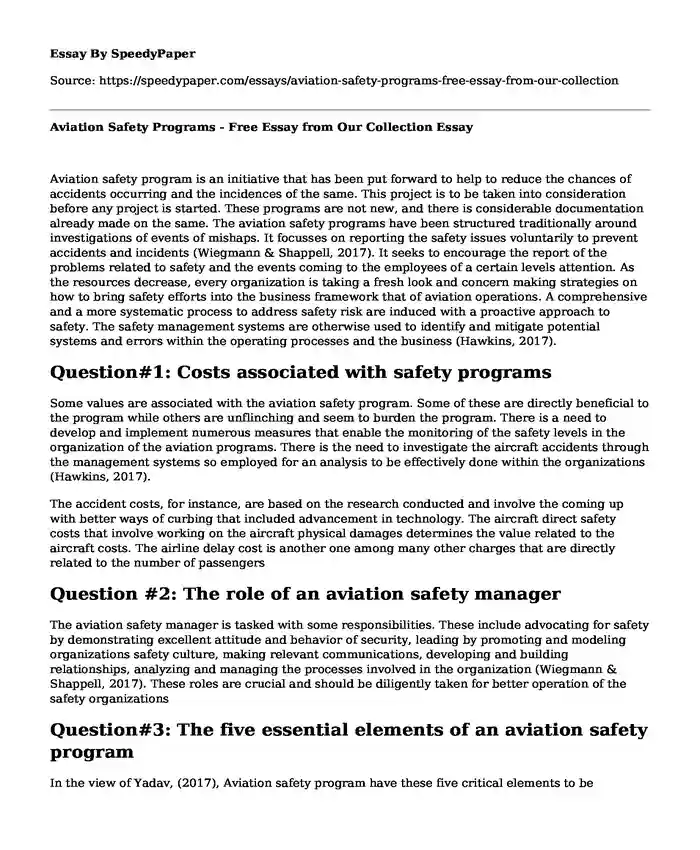Aviation safety program is an initiative that has been put forward to help to reduce the chances of accidents occurring and the incidences of the same. This project is to be taken into consideration before any project is started. These programs are not new, and there is considerable documentation already made on the same. The aviation safety programs have been structured traditionally around investigations of events of mishaps. It focusses on reporting the safety issues voluntarily to prevent accidents and incidents (Wiegmann & Shappell, 2017). It seeks to encourage the report of the problems related to safety and the events coming to the employees of a certain levels attention. As the resources decrease, every organization is taking a fresh look and concern making strategies on how to bring safety efforts into the business framework that of aviation operations. A comprehensive and a more systematic process to address safety risk are induced with a proactive approach to safety. The safety management systems are otherwise used to identify and mitigate potential systems and errors within the operating processes and the business (Hawkins, 2017).
Question#1: Costs associated with safety programs
Some values are associated with the aviation safety program. Some of these are directly beneficial to the program while others are unflinching and seem to burden the program. There is a need to develop and implement numerous measures that enable the monitoring of the safety levels in the organization of the aviation programs. There is the need to investigate the aircraft accidents through the management systems so employed for an analysis to be effectively done within the organizations (Hawkins, 2017).
The accident costs, for instance, are based on the research conducted and involve the coming up with better ways of curbing that included advancement in technology. The aircraft direct safety costs that involve working on the aircraft physical damages determines the value related to the aircraft costs. The airline delay cost is another one among many other charges that are directly related to the number of passengers
Question #2: The role of an aviation safety manager
The aviation safety manager is tasked with some responsibilities. These include advocating for safety by demonstrating excellent attitude and behavior of security, leading by promoting and modeling organizations safety culture, making relevant communications, developing and building relationships, analyzing and managing the processes involved in the organization (Wiegmann & Shappell, 2017). These roles are crucial and should be diligently taken for better operation of the safety organizations
Question#3: The five essential elements of an aviation safety program
In the view of Yadav, (2017), Aviation safety program have these five critical elements to be undertaken within the organization. These elements refer to the policies and the objectives that define the responsibilities, roles, and relationships of airline procedures and policies. They include:
- Safety Accountabilities;
- Management Commitment and Responsibility;
- Coordination of Emergency Response Planning; and
- Appointing Key Safety Personnel;
- SMS Documentation
Question# 4: Critical responsibilities for "Director of safety" as per the air Transportation Operation inspector's book.
According to Lilja & Ottosson (2018), the safety director is responsible for the role of the implementation of the policies and regulations of the organization. It is the director of safety who plays the role of making the safety rules they are put forward to be implemented in conjunction with other departments. The director is also responsible for the development of the institutional policies and making the organizations budget that includes expenses for operations, personnel, training, facility, and supply (Wiegmann & Shappell, 2017).
References
Hawkins, F. H. (2017). Human factors in flight. Routledge.
Lilja, K., & Ottosson, J. (2018). The risk of pioneering: Private interests, the State, and the launching of civil aviation in Sweden. The case of SLA 1918-23. The Journal of Transport History, 0022526618792379.
Wiegmann, D. A., & Shappell, S. A. (2017). A human error approach to aviation accident analysis: The human factors analysis and classification system. Routledge.
Yadav, B. K. (2017). Aircraft Collisions and Bird Strikes in Nepal Between 1946-2016: A Case Study. J Aeronaut Aerospace Eng, 6(203), 2.
Cite this page
Aviation Safety Programs - Free Essay from Our Collection. (2022, Jul 18). Retrieved from https://speedypaper.com/essays/aviation-safety-programs-free-essay-from-our-collection
Request Removal
If you are the original author of this essay and no longer wish to have it published on the SpeedyPaper website, please click below to request its removal:
- Export Financing in Nigeria, Problems and Prospects - Free Essay in Finance
- Essay Sample about Traveling Mercies by Anne Lamott
- Absolutism Essay Sample
- Art Essay Sample Describing the Carybe Painting
- Essay Example on Global and Regional Adverse Economic Conditions
- OHS Professionals Research Paper, Free Example
- Free Essay Example: Material Selection for Cladding
Popular categories





